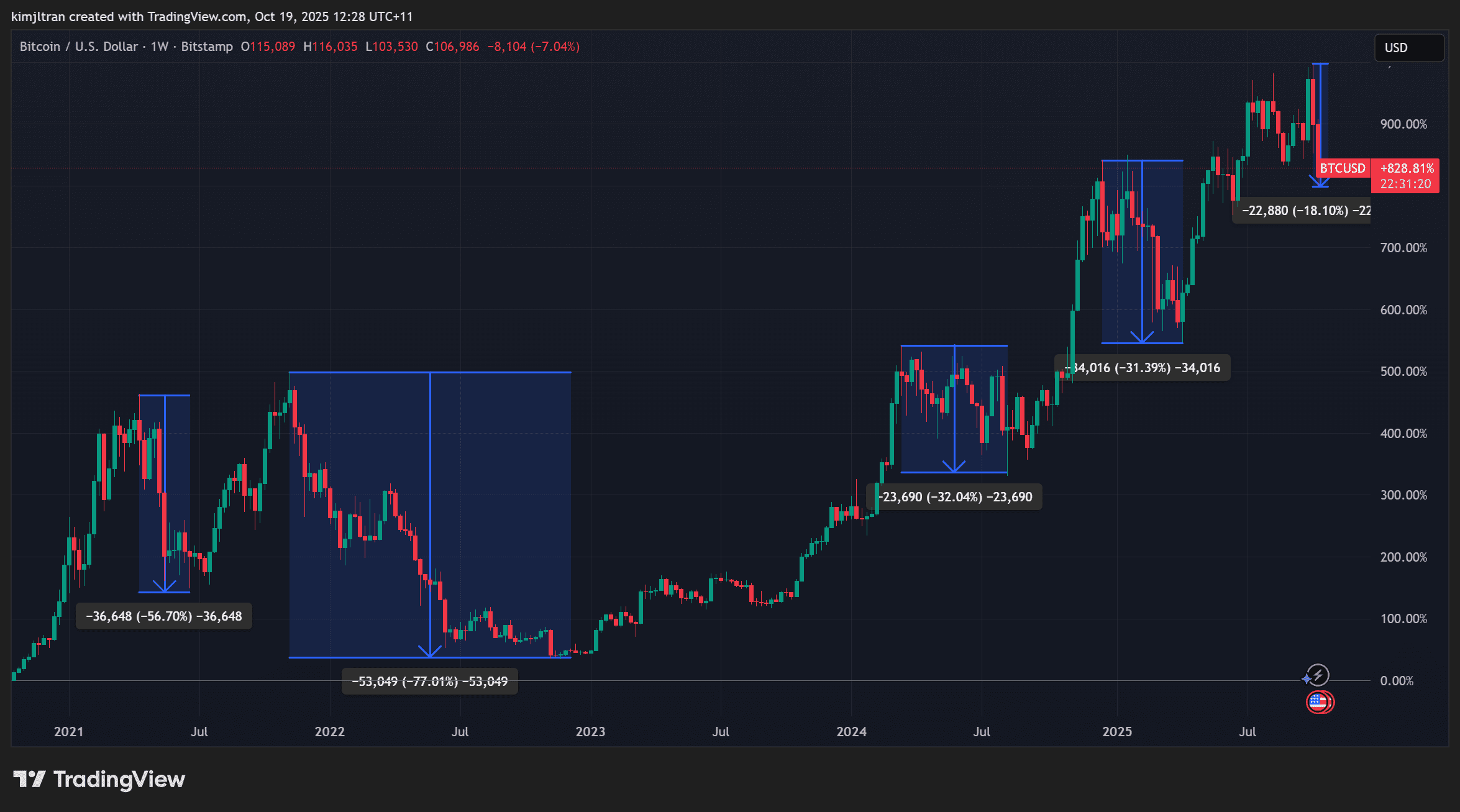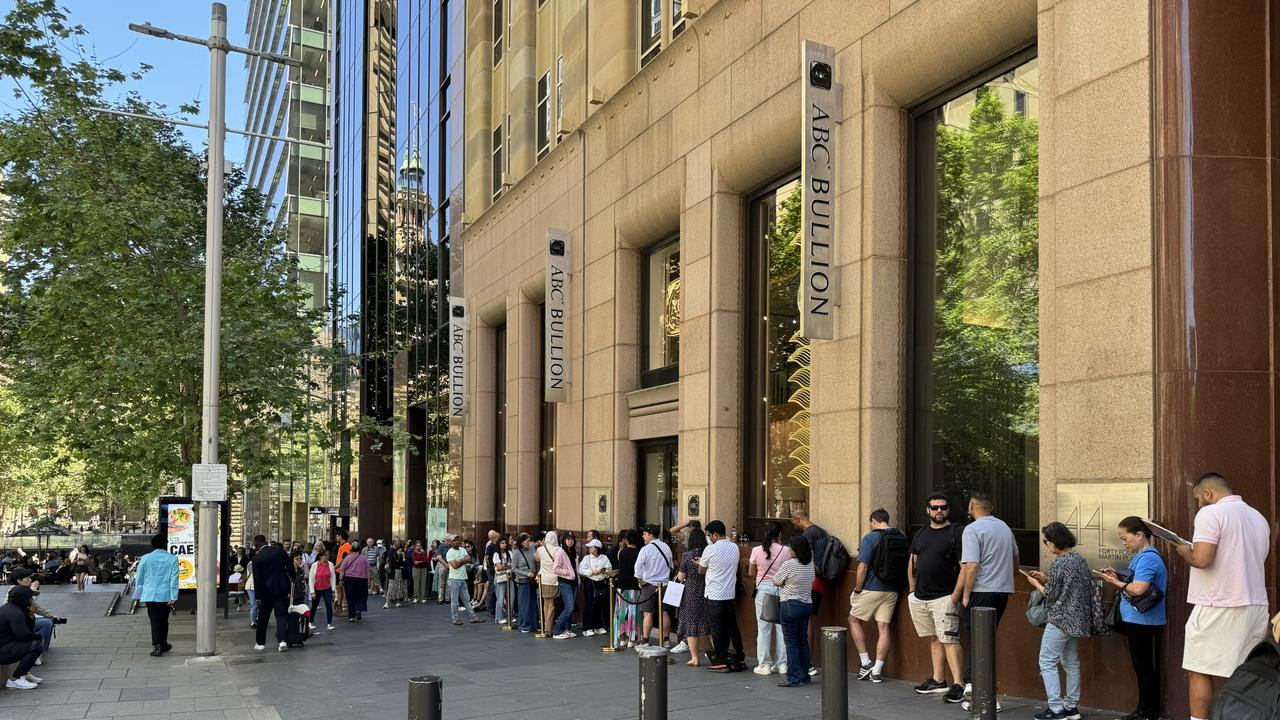Thanks for reading The BlockByte Weekly, where we summarise the key updates in crypto over the last week and provide our perspective on what you need to know as an investor.
Weekly Snapshot
- BTC: US $107,180 (-3.1%)
- Crypto Market Cap: US $3.64T (-1.4%)
- Gold: US $4,250/oz (+5.7%)
- S&P 500: 6,664 (+1.7%)
- ASX 200: 8,995 (+0.4%)
- 10-Year Treasury Yield: 4.01% (-4 bp)
Key Stories This Week
Market Recap: Volatility, Liquidity, and the Bigger Picture
Last weekend US $19B was wiped out from the digital asset market following Trump's threat to escalate tariffs to 100% on China. Markets remain well below their end of September highs, but have since stabilised. For disciplined investors, this phase underscores the importance of risk management and patience.
Are we at the top of the cycle?
We don’t believe so. The broader debasement trade — the idea that investors seek protection in hard assets like Bitcoin and gold as governments debase their currencies through persistent deficits and money creation — remains firmly intact. Both assets have historically benefited when real yields turn negative and liquidity expands, and that backdrop hasn’t changed.
Whilst Bitcoin has pulled back ~18% from its highs currently, this is far less than the 30%+ drawdowns typical of previous cycles, it remains up 15% year-to-date and 56% over the past 12 months. In our view this current drawdown is a much-needed consolidation phase, not a market top. As Arthur Hayes (Maelstrom co-founder and inventor of perpetual swaps) noted this week, liquidity — not the halving cycle — is now the primary driver of bitcoin and broader digital asset prices, and global liquidity continues to trend upward.

Gold has outperformed bitcoin both year-to-date and over the last 12 months. However, sentiment on gold may be near-term overbought as lines extend outside bullion dealers across the world.

That said, the US business and labour market suggest a gradual cooling, with the market said to be in a 'fragile balance' where a simultaneous drop in both labour demand and supply has kept the unemployment rate from rising faster. Combine this with record investment in AI across the board which is boosting GDP (with economic growth expected to be weaker without this support) and asset inflation.
These conditions are giving the Federal Reserve confidence for a near-certain rate cut on 29 October, which could provide the next liquidity tailwind, and traders are placing bets on a further easing before the end of 2025. However, with the US Government still in shutdown, traders are flying blind, relying on private data and high-frequency indicators in the absence of official economic reports.
Our take: This is a market with nervous sentiment, thin liquidity and where narratives seem to flip overnight. However, barring any major black-swan event or recession, we don’t see this as the end of the bull market (yet). Rather, indicators suggest it's a consolidation phase and healthy market reset — flushing out excess leverage and setting the stage for the next leg higher as liquidity conditions continue to improve.
Why We Focus on Highly Liquid Tokens
Hyperliquid CEO Jeff Yan and data firm CoinGlass have accused major centralised exchanges—particularly Binance—of significantly undercounting liquidations during last week’s US $19 billion crypto market crash. Yan highlighted that Binance’s system only reports one liquidation per second, even when hundreds occur, meaning real totals could be “100× higher” in extreme volatility. CoinGlass estimated US $16.7 billion in long liquidations on Friday alone, while Hyperliquid saw over 1,000 wallets wiped out.
Our take: An important reminder for investors when using leverage is that even with a stop loss order, if there is no liquidity for someone to buy, you may not be able to exit at the price you want during times of market stress. This is especially true for tokens with lower levels of liquidity. Tokens like XRP had drawdowns of ~40%, comapred to ~10% for bitcoin.
Binance Compensates Some Investors & Why They Lost their Australian License
Following the 10 October market crash that wiped out over US $20 billion in open interest, Binance confirmed it will only compensate users liquidated in wBETH, BNSOL, and USDe pairs. The exchange cited “abnormal market conditions” and pledged automatic refunds for eligible accounts affected between 21:36 and 22:16 UTC. Losses on other assets, including BTC and ETH, are excluded from the plan despite widespread system freezes and failed stop orders reported by traders.
Our take: The move to refund at least part of the ~US $2.4 billion liquidated on Binance, signals some goodwill towards their clients, however it's not unfeasible that this was a coordinated liquidation. For investors using leverage, we wouldn't use Binance for this very reason alone.
In 2023, Binance lost their ability to operate in Australia after they were found to be misclassifying retail clients as wholesale clients (thus depriving them of protections) and failing to meet regulatory obligations around disclosure, internal dispute resolution, and fairness.
BitMine Adds US $417 Million in Ethereum During Market Dip, mNAVs of Digital Asset Treasury Companies Continue to Decline
BitMine Immersion Technologies added 104,336 ETH — worth ~US $417 million — to its treasury this week, onchain data shows. The firm, led by Fundstrat co-founder Tom Lee, now holds 3.03 million ETH (about US $12.2 billion), the world’s largest corporate Ethereum position. Lee reaffirmed BitMine’s goal to accumulate 5% of ETH’s total supply, calling it a “neutral chain” likely to gain favour with US institutions.

Our take: We attended the latest TOKEN2049 talk in Singapore to listen to Tom Lee. We recommend watching the video above as we also find the long-term potential of Ethereum to be compelling as more institutions look to build and tokenise real-world assets on its blockchain. Institutional buying into near-term weakness signals deep conviction in Ethereum’s long-term value.
From an investor perspective however, it's important to note that the Market-to-Net Asset Value (mNAV) of digital asset treasury companies (DATs) has been going through a major compression phase as the market re-evaluates the investment proposition of buying dilutive equity based offerings, particularly when it's increasingly easy to gain direct exposure to the underlying asset instead.
Market-to-Net Asset Value (mNAV) compares a company's market capitalisation to the value of its cryptocurrency holdings to show whether the stock is trading at a premium or discount to its crypto assets — and has declined to ~1.8 over the last 6 months.

Until next week,
James
James Brannan
Managing Director
BlockByte
.png)
.png)